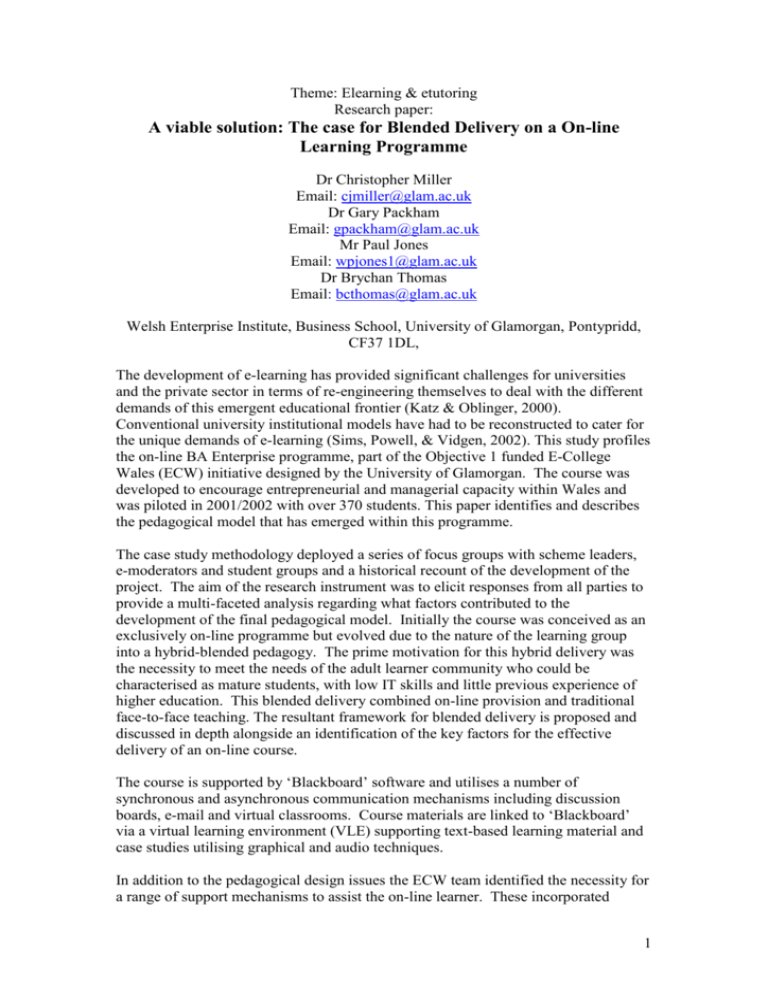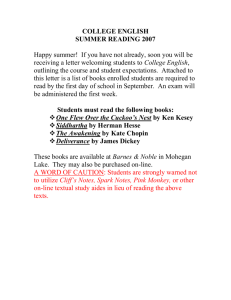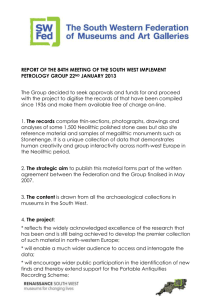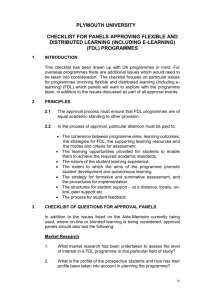Mr Paul Jones
advertisement

Theme: Elearning & etutoring Research paper: A viable solution: The case for Blended Delivery on a On-line Learning Programme Dr Christopher Miller Email: cjmiller@glam.ac.uk Dr Gary Packham Email: gpackham@glam.ac.uk Mr Paul Jones Email: wpjones1@glam.ac.uk Dr Brychan Thomas Email: bcthomas@glam.ac.uk Welsh Enterprise Institute, Business School, University of Glamorgan, Pontypridd, CF37 1DL, The development of e-learning has provided significant challenges for universities and the private sector in terms of re-engineering themselves to deal with the different demands of this emergent educational frontier (Katz & Oblinger, 2000). Conventional university institutional models have had to be reconstructed to cater for the unique demands of e-learning (Sims, Powell, & Vidgen, 2002). This study profiles the on-line BA Enterprise programme, part of the Objective 1 funded E-College Wales (ECW) initiative designed by the University of Glamorgan. The course was developed to encourage entrepreneurial and managerial capacity within Wales and was piloted in 2001/2002 with over 370 students. This paper identifies and describes the pedagogical model that has emerged within this programme. The case study methodology deployed a series of focus groups with scheme leaders, e-moderators and student groups and a historical recount of the development of the project. The aim of the research instrument was to elicit responses from all parties to provide a multi-faceted analysis regarding what factors contributed to the development of the final pedagogical model. Initially the course was conceived as an exclusively on-line programme but evolved due to the nature of the learning group into a hybrid-blended pedagogy. The prime motivation for this hybrid delivery was the necessity to meet the needs of the adult learner community who could be characterised as mature students, with low IT skills and little previous experience of higher education. This blended delivery combined on-line provision and traditional face-to-face teaching. The resultant framework for blended delivery is proposed and discussed in depth alongside an identification of the key factors for the effective delivery of an on-line course. The course is supported by ‘Blackboard’ software and utilises a number of synchronous and asynchronous communication mechanisms including discussion boards, e-mail and virtual classrooms. Course materials are linked to ‘Blackboard’ via a virtual learning environment (VLE) supporting text-based learning material and case studies utilising graphical and audio techniques. In addition to the pedagogical design issues the ECW team identified the necessity for a range of support mechanisms to assist the on-line learner. These incorporated 1 internal course monitoring mechanisms and external on-line support systems. Internal mechanisms included monitoring and encouraging student activity within individual learning groups, which were maintained by an academic on-line tutor. External systems included the Information Systems and e-learning Services (ISELS) department, whose role was to support the technical needs of the e-learning student and the Learning Resources Centre (LRC) section, which maintained and provided access to electronic and physical information sources for students and staff. The role of these bodies and systems is fully explained and illustrated within the blended delivery framework. In summary, this paper presents the critical issues in building a workable and manageable e-learning pedagogy for an emerging on-line programme. This contributes significantly to the limited literature in this field and could be utilised as a practical guide in the effective management of pedagogical issues associated with online learning. 503 Katz, R. & Oblinger, D. (2000). The ‘E’ is for Everything: E-commerce, E-business and Elearning in the Future of Higher Education, Jossey-Bass Inc., San Francisco. Sims, J., Powell, P. 7 Vidgen. R. (2002). 2+2=3? Elearning Strategies in HE, UKAIS conference, Leeds, 10-12 April, pp122-131. 2








